- Types of Sailboats
- Parts of a Sailboat
- Cruising Boats
- Small Sailboats
- Design Basics
- Sailboats under 30'
- Sailboats 30'-35
- Sailboats 35'-40'
- Sailboats 40'-45'
- Sailboats 45'-50'
- Sailboats 50'-55'
- Sailboats over 55'
- Masts & Spars
- Knots, Bends & Hitches
- The 12v Energy Equation
- Electronics & Instrumentation
- Build Your Own Boat
- Buying a Used Boat
- Choosing Accessories
- Living on a Boat
- Cruising Offshore
- Sailing in the Caribbean
- Anchoring Skills
- Sailing Authors & Their Writings
- Mary's Journal
- Nautical Terms
- Cruising Sailboats for Sale
- List your Boat for Sale Here!
- Used Sailing Equipment for Sale
- Sell Your Unwanted Gear
- Sailing eBooks: Download them here!
- Your Sailboats
- Your Sailing Stories
- Your Fishing Stories
- Advertising
- What's New?
- Chartering a Sailboat
- Cruising Yachts 35' to 40'

The S2 11.0 Sailboat
The S2 11.0 is a series of American cruising sailboats that were designed by Arthur Edmunds and built by S2 Yachts, a company founded by Leon Slikkers, a former Chris Craft employee who started his own boatbuilding business in 1973.

Published Specification for the S2 11.0C
Underwater Profile: Fin keel with skeg-hung rudder
Hull Material: GRP (Fiberglass)
Length Overall: 36'0" (11.00m)
Waterline Length: 28'3" (8.6m)
Beam: 11'11" (3.6m)
Draft: 5'6" (1.7m) deep draft version; 4'6" (1.4m) shoal draft version
Rig Type: Masthead Sloop
Displacement: 15,000lb (6,804kg)
Designer: Arthur Edmunds
Builder: S2 Yachts (USA)
Year First Built: 1980
Year Last Built: 1987
Number Built: 66
Published Design Ratios for the S2 11.0C
1. Sail Area/Displacement Ratio: 15.8
2. Ballast/Displacement Ratio: 37.5
3. Displacement/Length Ratio: 317
4. Comfort Ratio: 29.9
5. Capsize Screening Formula: 1.9
read more about these all-revealing numbers...
Summary Analysis of the Design Ratios for the S2 11.0C
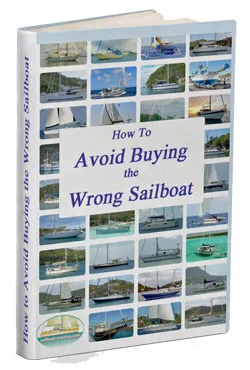
1. A Sail Area/Displacement Ratio of 15.8 suggests that the S2 11.0C will need a stiff breeze to get her going. In light conditions, unless you've got plenty of time on your hands, motor-sailing may be the way to go.
2. A Ballast/Displacement Ratio of 37.5 means that unless the bulk of the ballast is concentrated in a bulb at the foot of her keel, the S2 11.0C will have a tendency to heel excessively in a gust, and she'll need to be reefed early to keep her sailing upright in a moderate breeze.
3. A Displacement/Length Ratio of 317, tells us the S2 11.0C is clearly a heavy displacement cruising boat. You can load her down with all your cruising gear and equipment and it will hardly affect her waterline. Not an ideal choice for coastal sailing, but she'll come into her own on an offshore passage in testing conditions.
4. Ted Brewer's Comfort Ratio of 29.9 suggests that crew comfort of a S2 11.0C in a seaway is similar to what you would associate with the motion of a moderate bluewater cruising boat - a predictable and acceptable motion for most seasoned sailors.
5. The Capsize Screening Formula (CSF) of 1.9 tells us that a S2 11.0C would be a safer choice of sailboat for an ocean passage than one with a CSF of more than 2.0.
Any Questions?
Is the S2 11.0 still in production and, if not, when did production end and how many of these sailboats were built?
No, the S2 11.0 is not in production anymore. Production ended in 1987, after 10 years of manufacturing. A total of 222 boats were built, including 156 aft-cockpit models (11.0 A) and 66 centre-cockpit models (11.0 C).
What is the history of the builders of the S2 11.0 and is the company still in business?
The builders of the S2 11.0 are S2 Yachts, a company founded by Leon Slikkers in Holland, Michigan, in 1973. Slikkers had previously worked for Chris Craft and had also established his own powerboat company, Slickcraft, which he sold to AMF in the early 1970s. Slikkers started S2 Yachts to build sailboats, initially focusing on trailerable models, then expanding to larger cruising auxiliaries and high-performance racers.
The S2 11.0 was part of the second wave of cruising sailboats that Slikkers developed in the late 1970s. In the early 1980s, Slikkers returned to building powerboats under the Tiara and Pursuit brands, and stopped producing sailboats in 1986. The company is still in business today as Tiara Yachts, with Leon's sons David and Bob at the helm, and Leon still involved as an active founder.
What is the S2 11.0 like to sail?
The S2 11.0 is a well-balanced and responsive sailboat that performs well in light to moderate winds and seas. The boat has a moderate displacement of around 15,000 pounds and a hull speed of around 7 knots. The boat has a good turn of speed on all points of sail, especially on a reach or a run, where it can easily achieve speeds over 6 knots. The boat is also easy to steer and tack, thanks to its spade rudder and fin keel. The boat can handle heavier winds and waves, but may need to reef early and reduce sail area to maintain control and comfort. The boat has a comfortable motion and a dry ride, with minimal heeling and hobby-horsing. The boat is also well-equipped for cruising, with a reliable diesel engine, a large fuel tank, and a spacious cockpit and cabin.
What is the average cost of a secondhand S2 11.0?
The average cost of a secondhand S2 11.0 depends on the year, condition, equipment, and location of the boat. According to the BUC Used Boat Price Guide, a 1981 model S2 11.0 (in both centre and aft-cockpit versions) has a retail value range today between $48,000 and $52,000 (Northeast and Mid-Atlantic region).
What other sailboats have been created by the designer of the S2 11.0?
The designer of the S2 11.0 is Arthur Edmunds, a naval architect who worked for S2 Yachts from 1977 to 1986. Edmunds designed several other sailboats for S2 Yachts, including the S2 8.0 (a trailerable cruiser), the S2 9.1 (a performance racer-cruiser), the S2 10.3 (a cruising sloop), and the S2 12.9 (a centre-cockpit cruiser). Edmunds also designed sailboats for other companies, such as Hunter Marine, Endeavour Yachts, and Gulfstar Yachts. Some of his notable designs are the Hunter 34, the Endeavour 37, and the Gulfstar 50.
The above answers were drafted by sailboat-cruising.com using GPT-4 (OpenAI’s large-scale language-generation model) as a research assistant to develop source material; to the best of our knowledge, we believe them to be accurate.
Recent Articles
Wauquiez Gladiateur 33 for Sale
Apr 10, 24 05:40 AM
'Cabo Frio', a Catalina Morgan 43 for sale
Apr 01, 24 08:35 AM
Live Aboard Boats For Sale
Mar 30, 24 07:02 PM
Here's where to:
- Find Used Sailboats for Sale...
- Find Used Sailing Gear for Sale...
- List your Sailboat for Sale...
- List your Used Sailing Gear...
Our eBooks...

A few of our Most Popular Pages...

Copyright © 2024 Dick McClary Sailboat-Cruising.com
S2 11.0 C Detailed Review
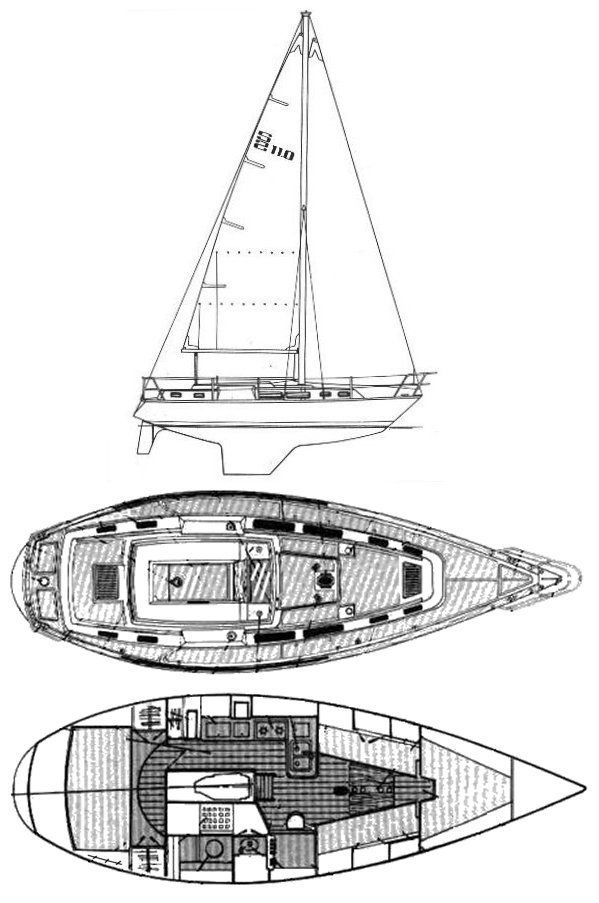
If you are a boat enthusiast looking to get more information on specs, built, make, etc. of different boats, then here is a complete review of S2 11.0 C. Built by S2 Yachts (USA) and designed by Arthur Edmunds, the boat was first built in 1980. It has a hull type of Fin with rudder on skeg and LOA is 10.97. Its sail area/displacement ratio 15.81. Its auxiliary power tank, manufactured by Pathfinder, runs on Diesel.
S2 11.0 C has retained its value as a result of superior building, a solid reputation, and a devoted owner base. Read on to find out more about S2 11.0 C and decide if it is a fit for your boating needs.
Boat Information
Boat specifications, sail boat calculation, rig and sail specs, auxillary power tank, accomodations, contributions, who designed the s2 11.0 c.
S2 11.0 C was designed by Arthur Edmunds.
Who builds S2 11.0 C?
S2 11.0 C is built by S2 Yachts (USA).
When was S2 11.0 C first built?
S2 11.0 C was first built in 1980.
How long is S2 11.0 C?
S2 11.0 C is 8.61 m in length.
What is mast height on S2 11.0 C?
S2 11.0 C has a mast height of 12.19 m.
Member Boats at HarborMoor
JavaScript seem to be disabled in your browser.
You must have JavaScript enabled in your browser to utilize the functionality of this website.
Edwards Yacht Sales

- 866.365.0706
1981 S2 11.0A
- Delray Beach, FL, US
Yacht price

- Email Broker
- Call Broker

Performance Cruiser - Quality Build - Turn Key
S2 Yachts were built in Holland, Michigan from 1974 thru 1989. Known for good build quality and sailing characteristics. ALOHA has been loved and updated by the seller since 2006. Set-up for short handed sailing and equipped for comfortable cruising - ALOHA will not disappoint.
Check this out:
- Less than 1000 hours on the 2009 rebuilt Volvo diesel
- Super Sailmakers 135 Head Sail, (2016)
- North Sails Main Sail, (2016)
- Mast, Pulled, Inspected & Painted (2010)
- Sta-Lok Standing Rigging by Andrew Wall
- LED Lighting - Interior, Steaming and Deck
- AIR Breeze Wind Generator
- Solar Panel, Siemens 75 Watt
- Toilet, Raritan LECTRA/SAN MC
- New Bottom Paint Oct 2015
Don't hesitate - make an appointment to see ALOHA today!
Specifications
Descriptions, basic information, dimensions & weight.
- View Option

Measurements
- L.O.A.: 36' 00" / 10.97m
- D.W.L.: 28' 3" / 8.62m
- Beam: 11' 11" / 3.38m
- Draft: 5' 5" / 1.68m
- Bridge Clearance: 49' 00" / 14.94m
- Displacement: 15000 lbs./ 6804 kgs.
- Ballast: 6000 lbs. / 2722 kgs. (Lead)
- Keel: Fin w/Skeg Rudder
- Interior Headroom: 6' 3" / 1.8m
- Fuel: 50 gals. / 189 ltrs. Aluminum
- Fresh Water: 80 gals. / 303 ltrs. Aluminum
- Holding - (Was removed, but can be reinstalled) NO NEED On-Board Waste Treatment Raritan LECTRA/SAN MC Exceeds USCG Type I requirements and was granted Type I label certification
Accommodations
Upon entering ALOHA via the companionway the S2 timeless quality combined with pride of ownership is immediately evident. To port is the fully appointed, U-shaped galley with gimballed 2 burner range/oven, spacious top loading refrigeration and double stainless sink. Across to Starboard is the aft quarter berth which can easily sleep two. Includes teak shelf outboard, storage under and port light. The fold-down navigation table is forward of the aft quarter berth. Forward of the Nav Station and galley is built-in seating which can be used as a single berth. Along the stbd side are teak cabinets, bookshelves and storage under the settee. Across to the port side is a U-shaped settee with table. The salon table folds down to become a double berth. Forward on the stbd side is the head with vanity, shower and Raritan LECTRA/SAN MC toilet - no need for a holding tank . The forward cabin has a V-berth, storage drawers under and hanging locker. The classic teak and holly cabin sole and teak joinery makes the interior feel warm and inviting.
Interior Details
- R everse Cycle A/C, Marine Air - 16,000 BTU
- Interior Upholstery Replaced in 2007
- LED Lighting
- Teak and Holly Sole - Good Condition
- U-shaped design w/Formica surfaces, teak sea rails on all edges.
- Adler Barbour Refrigeration, Top Load, 12 Volt
- Gimballed two burner Alcohol Origo Stove & Oven
- Double s/s sink w/hot and cold pressure water tap, manual pump
- Upper & Lower Storage Cabinets
The head compartment includes a shower fully enclosed by a wrap-around curtain on an overhead track. Raritan LECTRA/SAN MC toilet eliminates hose and tank oder, plus no more pump-out! Mirror, overhead hatch, opening port contoured teak vanity and convenient storage areas.
Electronics & Navigation
- Raymarine Autohelm ST6000 Wheel Autopilot
- Datamarine Wind Instruments
- Datamarine Depth
- Datamarine Speed
- Richie Magnetic Compass at Helm & Nav Station
- VHF, ICOM, Model IC-M422
- Stereo, Jensen
- Marine Interior & Exterior Speakers
- Diesel, 35 H.P., Volvo MD17C, Less than 1000 hours on rebuild .
- 3 blade fixed propeller
- Racor Fuel/Water Separator
- Sound insulated engine compartment w/access from front and sides.
- Spares include, belts, hoses, heat exchanger, alternator
Electric & Plumbing
- Four (4) 6 Volt Golf Cart Batteries for Start & House (2017)
- Battery Charger, ProMariner ProSport12
- Air Breeze Marine Wind Generator
- Solar Panel, 75 Watt
- A/C, D/C Electrical Panel
- 30 Amp Shore Power Cord
- 12V LED Lighting Fixtures
- Water Heater, (Runs off the diesel or 110v)
- Pressure water system with hot and cold water tap in galley and head.
- Manual water pump in galley
- Electric bilge pump w/auto switch (2015)
- Manual bilge pump (2016)
Sails, Rigging & Hardware
- Aluminum Mast, Pulled, Inspected & Painted (2010)
- Super Sails 135% Roller Furling Head Sail (2016)
- North Sails Main, (2016)
- Furler, Harken (2010)
- Standing Rigging - Replaced by Andrew Wall (2007)
- Running Rigging (2006) Good Condition
- Winches, Lewmar 44 ST (2), Barient 8P (1), Lewmar 16 (1), Lewmar 30 ST (1)
- Whisker pole
- Mainsail cover
- Winch handles
- Dodger & Bimini
- Wheel Steering
- Double lifelines w/quick release hooks
- Welded s/s double bow rail & stem rail, stanchions.
- Swim ladder
- Dinghy Davits
- RIB Dinghy w/Suzuki 6 hp (2012)
Anchoring & Safety
- Windlass - Manual
- Fortress 45 lb Anchor w/Chain & Nylon Rode
- Misc. PFD's
Personal items
Brokers Comments
ALOHA is in good condition and ready for a new owner to leave the dock bound for adventure. Spacious and an excellent choice for a coastal cruiser. ALOHA is a great choice for a budget/quality minded buyer.
- Less than 1000 hours on the rebuilt Volvo diesel
The Company offers the details of this vessel in good faith but cannot guarantee or warrant the accuracy of this information nor warrant the condition of the vessel. A buyer should instruct his agents, or his surveyors, to investigate such details as the buyer desires validated. This vessel is offered subject to prior sale, price change, or withdrawal without notice.
Presented by
Kirk muter 2 listing(s).
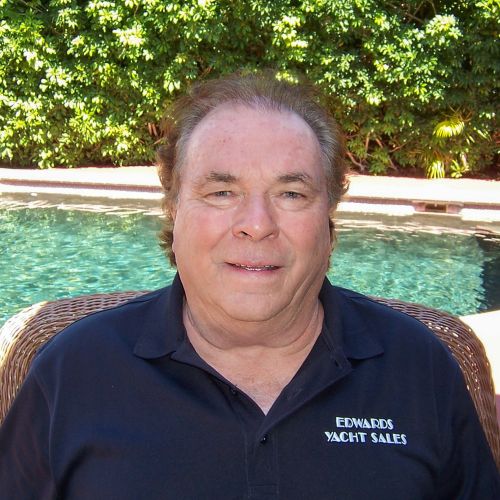
- 954.649.4679 727.449.8222
- View Profile
Manufacturer
Length Range Length Range
Year Range Year Range
Price Range Price Range
QUICK SEARCH BY:
Buyer services, featured yacht.
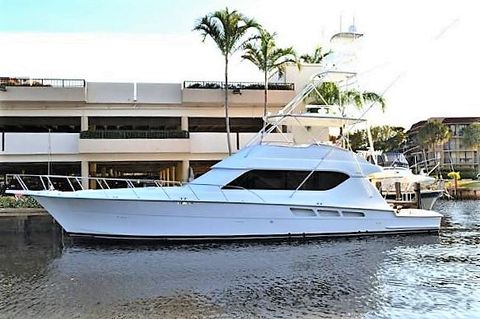
2001 Hatteras Sportfish
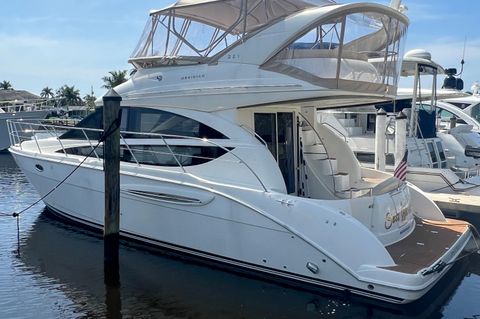
2011 Meridian 391 Sedan

2019 Monachus Issa 45

1981 Hatteras 48 Motor Yacht

1996 Tiara Yachts 3500 Express

2021 Stamas 390 Aegean
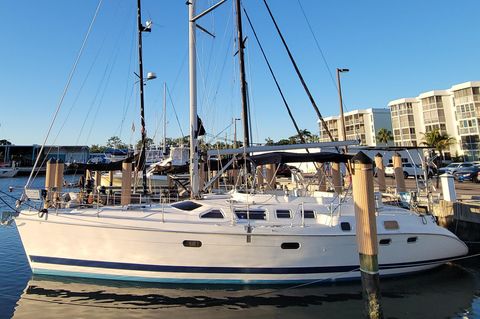
2002 Hunter 450 Passage
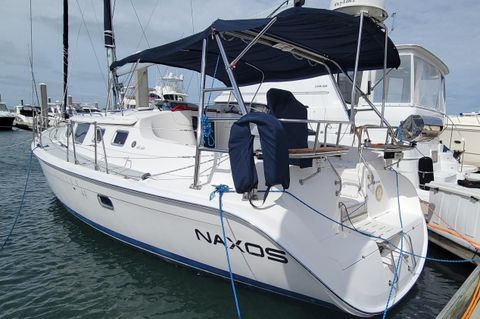
2007 Hunter 44 Deck Salon

1985 Ocean Yachts 55 Super Sport

2007 Meridian 391 Sedan
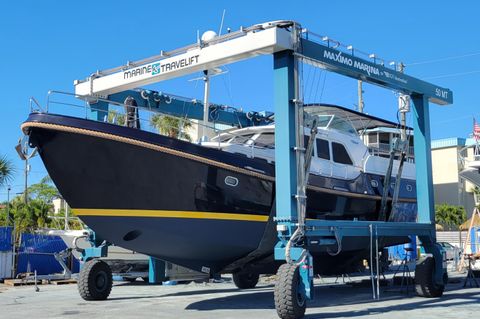
2002 Linssen 470 Grand Sturdy

1985 Morgan 31 Off Shore Fishing Cuddy

2007 Sea Ray Sundancer 40
- Google Plus
- Boats For Sale
- Brokerage Services
- Sold Yachts
Whether you are buying or selling your next boat or your first boat, one of Edwards Yacht Sales 45+ Professional Yacht Brokers throughout the Southeast are here to assist. Since 2003 we have acted as our clients trusted advisor throughout the entire process from shopping, to making an offer, to sea trial and survey, to closing.
Corporate Office: 510 Brookside Drive Clearwater, FL 33764
Email: [email protected]
Phone: 727.449.8222 Toll Free: 866.365.0706 Fax: 727.298.0456
Copyright © 2024 Edwards Yacht Sales Do Not Sell My Personal Information Powered by YachtCloser

We have placed cookies on your device to help make this website better.
You can use this tool to change your cookie settings. Otherwise, we’ll assume you’re OK to continue.
Some of the cookies we use are essential for the site to work.
We also use some non-essential cookies to collect information for making reports and to help us improve the site. The cookies collect information in an anonymous form.
To control third party cookies, you can also adjust your browser settings .

- Forum Listing
- Marketplace
- Advanced Search
- About The Boat
- Boat Builders Row
- SailNet is a forum community dedicated to Sailing enthusiasts. Come join the discussion about sailing, modifications, classifieds, troubleshooting, repairs, reviews, maintenance, and more!
S2-11 for blue water?
- Add to quote
Hi, I'm looking for a boat to take me from Seattle to Mexcio and back, and up the coast of BC to Alaska. I've heard very good things about S2's but I have no personal experience with them. - Are they suitable for that plan, including the "uphill" run from Mexico back to Seattle? - Have people cruised extensively in unprotected waters with them? - Any ocean crossings? (not in my plans, but useful info anyway) - Is the hull/deck joint thru-bolted? - How's the construction strength and quality compare to 70's & 80's Pearsons (which I am familiar with). Thanks for any help. Craig
S-2s are well made coastal cruisers as are Pearsons, and I would say both are comparable for consturction with S-2 having better finishing. My last purchase was almost a S-2 10.3 and I've always lusted for a 9.1. However, these boats like most Pearsons were not designed for offshore use. You can roll the dice and try taking one anywhere and its likely to get your there, but how gracefully, certainly or comfortably is a different question. I always offer the story http://www.equipped.com/0698rescue.htm as demonstrating how a boat that may be capable of offshore sailing may not be suitable. Now some Catalina owners reading that article come back and say, well the owner didn't prep enough, he missed a recall, he this-or-that. The truth is that boats designed to be compentent coastal cruisers are not suitable for offshore use.
I have owned an S2 11.0A for a number of years that I sail mainly on the Chresapeake Bay and have taken it up and down the east coast. An excellent coastal cruiser, substantial displacement, good tankage, and very stable and able boat. I would take it offshore coastal and to Bermuda, but not across and ocean. It would need some modification for offshore, especially storm shutters on the large lexan ports.
Cadence10m, I own a 11.A S2 and have sailed her offshore quite a bit. 2006 2007 Cruise Here is a link to a log of our most recent trip from Texas to the Bahamas and back. We just returned in April so I haven't completed the web log yet. We went across the Gulf directly to Florida and back. Took 7 days nonstop offshore each way so we saw quite a bit of Blue Water sailing. Also crossed the Gulf stream twice from Marathon to Bimini, 130 nautical miles. Then Gun Cay to Miami. The Gulf of Mexico has notoriously bad weather associated with frontal passages. We saw several hours of 40 knot winds on the way over and an hour of 45-50 knot winds with 15ft breaking seas on the way back. The boat handled these conditions fine. You do have to use some sense and reduce sail early in those conditions. Sailing upwind in rough seas the boat pounds some due to the flat entry forward. This is a bit uncomfortable but not dangerous. The hull to deck joint is thrubolted every 4-6 inches and very stout. The interior is built in wood glassed into the hull. This is superior to Pearsons, Catalinas, and most other production boats. The standing rigging and chain plates are heavier than those on most comparable Blue Water boats. I do carry emergency storm shutters in case one of the large lexan windows fail. The bilge sump is about 4 feet deep so no problem with water sloshing around out of reach of the pump. The boat had no opening in the sole over the sump so I cut one. Had to clean everything that had collected there over 20 years. I would not take my S2 around the world but have no problem with going anywhere in the Caribbean. Dave
- ?
- 174.1K members
Top Contributors this Month

- Forums New posts Unanswered threads Register Top Posts Email
- What's new New posts New Posts (legacy) Latest activity New media
- Media New media New comments
- Boat Info Downloads Weekly Quiz Topic FAQ 10000boatnames.com
- Classifieds Sell Your Boat Used Gear for Sale
- Parts General Marine Parts Hunter Beneteau Catalina MacGregor Oday
- Help Terms of Use Monday Mail Subscribe Monday Mail Unsubscribe
S2 11 sail performance Vs. Islander 36
- Thread starter jibseaman
- Start date Aug 23, 2011
- Brand-Specific Forums
I am trying to find out just how well these boats perform under sail. I am deciding if I should get an S2 11A or a Islander 36. The Islander is said to reach 8kts but what about the S2? I know the S2 is one ft wider and looks to be built well but how much performance do you give up for the extra room down below? Anyone with info or opinions an these two, I'd love to hear it.
I don't own either, but faced with the same issue I used PHRF to get a handle on the relative speed of two boats. PHRF lists the base handicap of the I36 as 144 while the base handicap of the S2 11.0 is down as 138. If you want a fast boat go for the S2 10.3, which is 120. Note that the I36 is a proven circumnavigator with a keel stepped mast. I don't know if an 11.0 has been around yet. There is a ton of info at http://www.islander36.org The 11.0 has a ton of space in the center cockpit version. The I37 has a pilothouse, which might be a nice option to have (steer inside with the AC on). Will you live aboard? The I36 draws 6 feet even while the 11.0 draws 5.5 feet. Given the potential to run aground if you head to the islands or spend time in the ICW I don't know if I would want an integral keel. If you ground the 11.0 (racing S2's like the 10.3 are bolt on) you should haul it to make sure you didn't penetrate the keel walls which will waterlog the keel (lead shot/scrap in the molded in keel secured with resin). I'd go for a shoal keel on either were I you. Note that the I36 keels seem a mix of iron and lead. Go for lead if possible. Up here, I'd love either boat, but find the S2 more attractive (not surprisingly).
Thanks for the PHRF info, I am surprised that the S2 should sail faster as it is nearly a foot wider. The S2 is a later design than the Islander, could it be that they were built under different racing rules? I am unfamiliar with what these changes imply in hull shape and performance or when they went into effect. I am guesing the S2 is faster because of the larger sail area. I live in the south FL area so I do indeed want a shool draft and these two boats are the same 4'8". I will mostly be sailing weekends and trips to Bahamas/Keys doing overnighters. How bad of a situation can it be if the encapsulated keel has been damaged ether now or sometime in the past?
Up north it can be a nightmare due to freezing. The whole ballast area (usually the front 75% of the keel with a sump in the aft 25%) can become water-logged. If that freezes (not a problem you will have) it can severely damage the keel. In your case, it could sink the boat if it communicates with the bilge. Best practice is always to examine the keel carefully after any grounding. As long as you can dive on it (no problem in warm weather) and haul or fix it with underwater epoxy (best idea I heard is to create bandage by spreading epoxy on plastic wrap or a plastic bag to ease handling) you should be okay.
I think an integral keel is better than a bolt on type. Better built in my opinion. No keel bolts to worry about. Seems like it would be more expensive to produce an integral keel also.
Barnacle Bill
Speed potential is more sail area, waterline length, lighter vessel, rather than beam, other than the fact that when you heel over the beam will increase waterline length for certain vessels. I believe S-2 is considered to be a better built boat than the Islander, with better fiberglass work, but, as mentioned, the Islander 36 is a very well respected vessel with lots of experience on the water. I have just seen S-2's hold up better with time. A center cockpit boat usually does not sail as well as an aft cockpit boat because of the sail plan difference, more weight and windage. But, they can be more comfortable for cruising and most offer a great fishing platform aft where you do not have to bring fish guts into the living area of your aft cockpit. That's my 2 cents.
- This site uses cookies to help personalise content, tailor your experience and to keep you logged in if you register. By continuing to use this site, you are consenting to our use of cookies. Accept Learn more…
- New Sailboats
- Sailboats 21-30ft
- Sailboats 31-35ft
- Sailboats 36-40ft
- Sailboats Over 40ft
- Sailboats Under 21feet
- used_sailboats
- Apps and Computer Programs
- Communications
- Fishfinders
- Handheld Electronics
- Plotters MFDS Rradar
- Wind, Speed & Depth Instruments
- Anchoring Mooring
- Running Rigging
- Sails Canvas
- Standing Rigging
- Diesel Engines
- Off Grid Energy
- Cleaning Waxing
- DIY Projects
- Repair, Tools & Materials
- Spare Parts
- Tools & Gadgets
- Cabin Comfort
- Ventilation
- Footwear Apparel
- Foul Weather Gear
- Mailport & PS Advisor
- Inside Practical Sailor Blog
- Activate My Web Access
- Reset Password
- Customer Service

- Free Newsletter

What You Can Learn on a Quick Test Sail

Cabo Rico’s Classic Cutter

Bob Perrys Salty Tayana 37-Footer Boat Review

Tartan 30: An Affordable Classic

Preparing Yourself for Solo Sailing

Your New Feature-Packed VHF Radio

Preparing A Boat to Sail Solo


Solar Panels: Go Rigid If You have the Space…

When Should We Retire Dyneema Stays and Running Rigging?

Rethinking MOB Prevention

Top-notch Wind Indicators

The Everlasting Multihull Trampoline

Taking Care of Your 12-Volt Lead-Acid Battery Bank

Hassle-free Pumpouts

What Your Boat and the Baltimore Super Container Ship May Have…

Check Your Shorepower System for Hidden Dangers

Waste Not is the Rule. But How Do We Get There?

How to Handle the Head

The Day Sailor’s First-Aid Kit

Choosing and Securing Seat Cushions

How to Select Crew for a Passage or Delivery

Re-sealing the Seams on Waterproof Fabrics

Waxing and Polishing Your Boat

Reducing Engine Room Noise

Tricks and Tips to Forming Do-it-yourself Rigging Terminals

Marine Toilet Maintenance Tips

Learning to Live with Plastic Boat Bits
- Sailboat Reviews
Affordable Cruising Sailboats
Practical sailor reviews nine used boats over 35 feet and under $75,000..
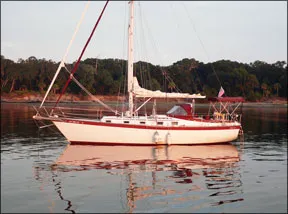
In a search for a budget cruiser, Practical Sailor examined a field of used sailboats costing less than $75K and built between 1978 and 1984. We narrowed the field to boats with sufficient accommodations for four people and a draft of less than 6 feet. One way to approach a used-boat search is to look for sailboats with informed, active owners associations and high resale values. Practical Sailor’s quest for recession-proof cruisers led us to the Allied Princess 36, Bristol 35.5C, Endeavour 37, S2 11.0, Freedom 36, ODay 37, Niagara 35, C&C Landfall 38, and the Tartan 37. The report takes a more in-depth look at the Tartan, C&C Landfall, and Niagara.
Let’s say you’re looking to buy a boat for summer cruising along the coastal U.S. or on the Great Lakes, one that, when the time is right, is also capable of taking you safely and efficiently to Baja or the Bahamas, and perhaps even island-hopping from Miami to the West Indies. Like most of us, your budget is limited, so a new boat is out of the question. Let’s set more specifics:
- Passes a thorough survey by a respected surveyor and has been upgraded to meet current equipment and safety standards. (These are old boats, after all, prone to all sorts of potentially serious problems.)
- Fun to sail inshore (which means not too heavy and not too big).
- Sufficient accommodations and stowage to cruise four people for two weeks.
- Popular model (active owners support group for help and camaraderie) with decent resale value
- Under $75,000.
- Monohull (multihulls violate the price cap, anyway).
- Draft of less than 6 feet (for the islands, mon).
In the February 2008 issue, we examined 30-footers from the 1970s , which is just above the minimum length for the Big Three: standing headroom, enclosed head, and inboard engine. Too small, however, to satisfy our new criteria. So we need to jump up in size. As we culled through the possibilities, we found a fairly narrow range of boat lengths and vintages that satisfy the criteria. Of course, there always are exceptions, but basically it is this: 35- to 38-footers built between 1978 and 1984. Bigger or newer boats that meet our criteria cost more than $75,000.
Heres the list of nine models we came up with: Allied Princess 36, Bristol 35.5C, C&C Landfall 38, Endeavour 37, Freedom 36, Niagara 35, ODay 37, S2 11.0, and the Tartan 37. All were built by reputable companies in the U.S. or Canada, with underwater configurations ranging from full keels with attached rudders to fin keels and spade rudders. Displacements are mostly moderate.
Below we present notes on six of the finalists. Details of our 3 favorites are linked to the right of this page.
ALLIED PRINCESS 36
Allied Yachts developed an excellent line of cruising sailboats in the 1960s, including the first fiberglass boat to circumnavigate, the Seawind 30 ketch, which later was expanded to the 32-foot Seawind II. The handsome Luders 33 was the boat in which teenager Robin Lee Graham completed his historic circumnavigation. Arthur Edmunds designed the full-keel Princess 36 aft-cockpit ketch and the larger Mistress 39 center-cockpit ketch. None of these boats are fancily finished, but the fiberglass work is solid and well executed. They’re ocean-worthy, and affordable. The Princess 36 was in production from roughly 1972 to 1982. Wed look for a later model year; prices are under $50,000.
BRISTOL 35.5C
Bristol Yachts was founded by Clint Pearson, after he left Pearson Yachts in 1964. His early boats were Ford and Chevy quality, good but plainly finished, like the Allieds. Over the years this changed, so that by the late 1970s and early 1980s, his boats were between Buicks and Cadillacs in overall quality. This includes the Ted Hood-designed 35.5C. Its a centerboarder with a draft from 3 feet, 9 inches board up to 9 feet, 6 inches board down; a keel version also was available (named without the “C”).The solid fiberglass hull was laid up in two halves and then joined on centerline. It had an inward-turning flange on the hull, superior to the more common shoebox hull-to-deck joint. The 35.5C is very good in light air, but tender in a breeze. Pick one up for around $60,000.
ENDEAVOUR 37
The Endeavour Yacht Corp. was founded in 1974, and its first model was a 32-footer, built in molds given to it by Ted Irwin. Yup, the Endeavour 32 has the same hull as the Irwin 32. Its second model was the Endeavour 37, based on a smaller, little known Lee Creekmore hull that was cut in half and extended. Its not the prettiest boat in the world, and not very fast, but heavily built. Owners report no structural problems with the single-skin laminate hull. It has a long, shoal-draft keel and spade rudder. What helped popularize the Endeavour 37 was the choice of layouts: an aft cabin with a quarter berth, a V-berth and quarterberth, and a (rare) two aft-cabin model. Production ended after 1983. Prices are around $50,000.
After the Halsey Herreshoff-designed Freedom 40 that reintroduced the idea of unstayed spars, several other designers were commissioned to develop the model line-up. These included David Pedrick and Gary Mull; the latter drew the Freedom 36, in production from about 1986 to 1989. While the early and larger Freedoms were ketch rigged, models like the 36 were sloops, which were less costly to build and easier to handle. To improve upwind performance, a vestigial, self-tacking jib was added. Thats the main appeal of these boats: tacking is as easy as turning the wheel. The 36s hull is balsa-cored, as is the deck. Balsa adds tremendous stiffness, and reduces weight, which improves performance. The downside: Core rot near the partners on this boat could lead to a dismasting and costly hull damage. Interior finishing is above average. These boats sell right at our price break: low to mid-$70s.
This low-profile family sloop was second only to the ODay 40 in size of boats built by ODay under its various owners. Founded by Olympic gold-medalist George ODay to build one-designs and family daysailers, subsequent ownership expanded into trailer sailers and small- to medium-size coastal cruisers. Like the others, the 37 was designed by C. Raymond Hunt Associates. The center-cockpit is a bit unusual but some prefer it. The cruising fin keel and skeg-mounted rudder are well suited to shallow-water cruising, and the generous beam provides good form stability. The hull is solid fiberglass, and the deck is cored with balsa. Owners report it is well balanced and forgiving. Early 1980s models are on the market for less than $40,000.
Built in Holland, Mich., the S2 sailboat line emerged in 1973 when owner Leon Slikkers sold his powerboat company, Slickcraft, to AMF and had to sign a no-compete agreement. The 11.0 was the largest model, introduced in 1977. The designer was Arthur Edmunds, who also drew the Allied Princess 36, though the two are very different. Edmunds resisted some of the bumps and bulges indicative of the International Offshore Rule (IOR), but still gave the 11.0 fine ends, and a large foretriangle. Two accommodation plans were offered: an aft cockpit with conventional layout of V-berth, saloon, and quarter berth and galley flanking the companionway; and an unusual center-cockpit layout with V-berth forward immediately followed by opposing settees, and then galley and head more or less under the cockpit. The master suite is in the aft cabin, of course. The hull is solid fiberglass and includes the molded keel cavity for internal ballast; the deck is balsa-cored. Overall construction quality is rated above average. Prices range from about $30,000 to $50,000.
NIAGARA 35: a handsome cruiser with Hinterhoeller quality.
Austria-born George Hinterhoeller emigrated to Canada in the 1950s and began doing what he did all his life: build boats, first out of wood, then fiberglass composites. He was one of four partners who formed C&C Yachts in 1969. He left in 1975 to again form his own company, Hinterhoeller Yachts. The company built two distinct model lines: the better known Nonsuch line of cruising boats with unstayed catboat rigs, and the Niagara line. About 300 Niagara 35s were built between 1978 and 1995.
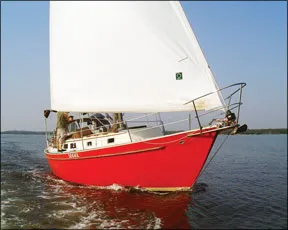
Canadian naval architect Mark Ellis designed the Niagara 35 as well as all of the Nonsuch models. He gave the 35 a beautiful, classic sheer with generous freeboard in the bow, swooping aft to a low point roughly at the forward end of the cockpit, and then rising slightly to the stern. The classic influence also is seen in the relatively long overhangs; todays trend is to lengthen the waterline as much as possible, with near plumb bows, discounting the old belief that overhangs were necessary for reserve buoyancy. So the Niagara 35 has a somewhat shorter waterline than the others in our group of nine, but as the hull heels, the overhangs immerse and sailing length increases. The short waterline also accounts for the 35s moderately high displacement/length ratio of 329. There is a direct correlation between the D/L and volume in the hull, and for a cruising boat, there must be sufficient space for tanks and provisions. Unfortunately, tankage in the 35 isn’t that much: 80 gallons water, 30 gallons diesel fuel, and 25 gallons holding tank.
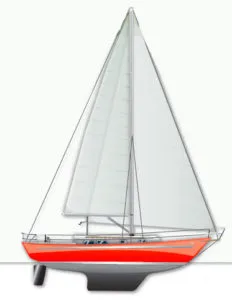
The cruising fin keel is long enough for the boat to dry out on its own bottom should the need arise, like drying out against a seawall in Bali to paint the bottom. (Sorry-just dreaming!) The spade rudder seems a little unusual for a cruiser. When asked about it, Ellis said that it provides superior control to a skeg-mounted rudder, and that skegs, which are supposed to protect the rudder, often aren’t built strong enough to do the job. Circumnavigator and designer/builder/developer Steve Dashew agrees that offshore, in nasty conditions, spade rudders are the way to go.
Construction
George Hinterhoeller and his associates at C&C Yachts were early advocates of balsa-cored hull construction, because it reduces weight, increases panel stiffness, and lowers costs. The worry, of course, is delamination of the core to the inner and outer skins should water penetrate through to the core. This is why quality builders remove balsa coring wherever through-hulls or bolts pass through the hull or deck, and fill the area with a mix of resin and reinforcements. Hinterhoeller was such a builder, but core integrity still deserves close inspection during a pre-purchase survey.
All bulkheads are tabbed to the hull and deck with strips of fiberglass, and this is an important detail for an offshore boat. Many mass-produced boats have molded fiberglass headliners that prevent tabbing bulkheads to the deck; rather, the bulkheads simply fit into molded channels in the headliner, which do not prevent them from moving slightly as the boat flexes in waves.
Hardware quality is good. One owner described the chocks and cleats on his Niagara as “massive.” Hatches are Atkins & Hoyle cast aluminum, which are about as good as you can buy. And the original rigging was Navtec rod. Owners report no structural problems.
Performance
With its moderately heavy displacement, conservative sailplan, and relatively large keel, the Niagara 35 is not a speed demon, and does not point as high as a boat with a deep, narrow fin keel. But thats not what were after here. The 35s specs are just about what we want for a versatile cruising boat. Owners say performance picks up quickly as the breeze fills in. If the sailplan were larger, for improved light-air performance, youd have to reef sooner, and reefing is work.
The long keel has another advantage, and that is improved directional stability over shorter keels, which means less effort at the helm. We tend to think that a powerful below-deck autopilot can steer any boat, but autopilots struggle, too. A boat thats easy for the crew to hand steer also is easy for the autopilot to maintain course.
A lot of Niagara 35s were equipped with Volvo saildrives rather than conventional inboard diesel engines. Advantages of the saildrive: improved handling in reverse and lower cost. Disadvantages: potential corrosion of aluminum housing and not as much power. Various inboard diesels were fitted: Westerbeke 27-, 33-, and 40-horsepower models, and a Universal M35D, all with V-drives. Owners rate access somewhat difficult.
Accommodations
Two interior layouts were offered: the Classic, in which the forepeak has a workbench, shelves, seat, and stowage instead of the usual V-berth; and the Encore, which has an offset double berth forward, and quarter berth and U-shaped galley aft. The saloon in the Classic, with settees and dining table, is farther forward than usual; the head and owners stateroom, with single and double berths, is aft. Both plans have their fans.
Headroom is 6 feet, 4 inches in the main cabin and 6 feet, 2 inches in the aft cabin. Berths are 6 feet, 7 inches long; a few owners say berth widths are a bit tight. A couple of thoughts on the double berths offered in these two plans: V-berths are subject to a lot of motion underway and so do not make great sea berths, but at anchor, ventilation via the forward hatch makes them far more comfortable than a stuffy aft cabin, where its much more difficult to introduce air flow. Offset double berths do not waste outboard space like V-berths do, but the person sleeping outboard must crawl over his/her partner to get out of bed.

Thirty-year-old boats should be surveyed thoroughly. Nothing lasts forever, but boats well maintained last a lot longer. Pay particular attention to the balsa-cored hull and deck. If either has large areas of delamination, give the boat a pass, because the cost to repair could exceed the value of the boat.
A few owners expressed concern about the boats handling off the wind, which surprises us somewhat. A test sail in lively conditions should answer that question.
We much prefer the inboard. If you prefer the saildrive, look for signs of corrosion and get a repair estimate.
Niagara 35 Conclusion
The Niagara 35 is a handsome, classically proportioned cruising sloop from one of the best builders of production boats in North America. It is not considered big enough these days to be a circumnavigator, but certainly large enough for a couple to leisurely cruise the Bahamas, Caribbean Sea, and South Pacific. We found asking prices ranging from around $54,000 to $89,000, with most in the $60,000 range.
C&C LANDFALL 38
As noted, George Hinterhoeller was one of four partners who formed C&C Yachts in 1969, at Niagara-on-the-Lake, Ontario. The others were Belleville Marine, Bruckmann Manufacturing, and the design firm of George Cuthbertson and George Cassian. From the beginning, the emphasis was on performance. Indeed, the 40-foot Red Jacket won the 1968 Southern Ocean Racing Circuit (SORC).
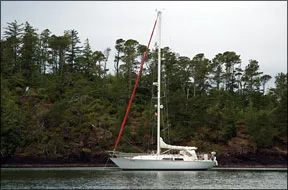
In 1973, Cuthbertson retired to his Ontario farm, citing burn-out. Eight months later, he was back as president of C&C Yachts, telling staff that they ought to pursue more multi-purpose racer/cruiser models. C&C became the dominant boatbuilder in North America, with models ranging from the C&C 24 to the C&C 46, with models just about every 2 feet in between. The Landfall cruiser series was introduced in 1977, with the Landfall 42. It was followed by the Landfall 35, 38, and 48. Production of the 38 ran from 1977 to 1985, with about 180 built.
The C&C Landfall 38 is directly related to the earlier C&C 38. We wrote in our original 1983 review that the older hull design was “…modified with slightly fuller sections forward, a slightly raked transom rather than an IOR reversed transom, a longer, shoaler keel, and a longer deckhouse for increased interior volume.” The spade rudder is not everyones first choice on a serious cruising boat, but it does provide superior control. And the Landfalls have a higher degree of finish inside, along with layouts more suited to family cruising.
The Landfalls perform very well, thanks to lightweight construction and speedy hull forms. The Landfall 38s displacement/length ratio of 272 is the lowest of the three compared in this review.
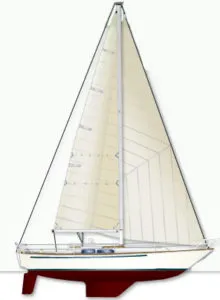
Notable drawbacks: a V-berth that becomes quite narrow forward, and as noted in the 1983 review, “a hull that rises so quickly aft that C&Cs normal gas bottle stowage at the end of the cockpit is eliminated.” This on a cruising boat no less, where a hot meal is often the highlight.
Like nearly all the C&C designs, the Landfall 38 is attractively proportioned with sleek lines and a modern look, even several decades later. It appears most dated in the raked bow, but this better suits the anchoring duties on a cruising boat anyway.
Materials and building processes used in C&C Yachts are very similar to those of the Niagara 35, namely because of Hinterhoeller. Practices he established at C&C continued after he left, at least for the short-term. So what we said about the Niagara 35s balsa-core construction also applies to the Landfall 38, where it is found in the hull, deck, and cabintop.
The hull-deck joint is through-bolted on 6-inch centers, through the teak toerail, which gaves the Landfall series a more traditional look than the distinctive L-shaped anodized aluminum toerail Cuthbertson designed and employed on the rest of the C&C models. The joint is bedded with a butyl tape, which does a good job of keeping out water, but doesn’t have the adhesive properties of, say, 3M 5200. On the other hand, if you ever had to remove the deck-heaven forbid!-it would be a lot easier.
Deck hardware is through-bolted with backing plates or large washers, although some of the fasteners come through on the underside, where the core transitions into the core-less flange. We also saw this on our old 1975 C&C 33 test boat. It means two things: water migrating down the fastener after the bedding fails can contact a little bit of balsa, and uneven stresses are placed on the fastener, which above deck can cause gelcoat cracks.
Proper bronze seacocks protect the through-hulls, and hoses are double-clamped for added security. The mast butt is not deep in the bilge where it can corrode in bilge water, but rests on two floor timbers in the sump, above any water that would typically collect.
The external lead-ballast keel is bolted through the keel sump in the hull. Its run is flat, and the boat can sit on its keel, allowing it be careened against a seawall for bottom painting, prop repairs, or other work in locales where boatyards are rare.
In our earlier review, we noted that the engine compartment has no sound insulation, despite its proximity to the owners berth, but gluing in some lead-lined foam is within the capability of most owners.
Despite being 2,000 pounds heavier than the C&C 38, the Landfall 38 is still a quick boat. Its old PHRF rating of 120 is just a little higher than the Cal 39 at 114, and less than the Tartan 37 we’ll look at next.
The mast is a little shorter than that of the C&C 38, but as with most boats of the IOR era, the Landfall 38 has a large foretriangle of 385 square feet. A 150-percent genoa measures 580 square feet, which is a handful for older crew. Roller furling with maybe a 135 percent genoa would be a logical way to minimize the effort required to tack this boat.
Strangely, the Landfall 38 did not come standard with self-tailing winches; a highly recommended upgrade. The main halyard, Cunningham, and reefing lines are led aft to the cockpit, while the headsail halyards run to winches on deck near the mast.
The boat is stiff and well balanced. Owners like the way it handles and appreciate its speed.
The standard engine was a 30-hp Yanmar diesel. The early Yanmar Q series had a reputation for being noisy and vibrating a lot. At some point, C&C began installing the Yanmar 3HM which replaced the 3QM. Power is adequate. The standard prop was a solid two-blade. Engine access leaves a lot to be desired.
The interior is pushed well into the ends of the boat to achieve a legitimate three-cabin accommodation plan. The standard layout was a V-berth forward with cedar-lined hanging locker. The berth narrows quickly forward so that tall people might not find enough foot room. Moving aft, there is a dinette and settees in the saloon, U-shaped galley and large head with shower amidships, and a double berth in the port quarter, opposite a navigation station. In rainy or wild weather, youll want to close the companionway hatch and keep weather boards in place so that water doesn’t spill into the nav station. Installing Plexiglas screens on either side of the ladder will help.
Oddly, there is no place to install fixed-mount instruments outboard of the nav table; that space is given to a hanging locker, but could be modified. Other than this, about the only other shortcoming is that the toilet is positioned so far under the side deck that persons of average size cannot sit upright. And, the head door is louvered, which compromises privacy.

There is not a lot to complain about with the Landfall 38 that we havent already said: the V-berth forward is tight, theres no sitting upright on the toilet, theres no place to install electronics at the nav station, and the nav station and aft berth invite a good soaking through the companionway.
Construction is above average, but have a surveyor sound the hull and decks for signs that the fiberglass skins have delaminated from the balsa core. Small areas can be repaired, but our advice is not to buy a boat with widespread delamination.
Landfall 38 Conclusion
The Landfall 38 is an excellent family boat and coastal cruiser. Its popularity in the Great Lakes region is not surprising. Island hopping to the Caribbean is also within reach, but any longer cruises will likely require more tank capacity and stowage. Standard tankage is 104 gallons water and 32 gallons of fuel. Prices range from around $55,000 to $65,000.
TARTAN 37: shoal draft and S&S styling.
In the early years of fiberglass boat construction, the major builders-Columbia, Cal, Morgan, Tartan, and others-commissioned well-known naval architects to design their models. Today, this work is more often done by a no-name in-house team over which the company has more control. Tartan Yachts of Grand River, Ohio, relied almost exclusively on the prestigious New York firm of Sparkman & Stephens; they’d drawn the Tartan 27 for the company’s antecedent, Douglass & McLeod, and were called on again to design the Tartan 37, which had a very successful production run from 1976 to 1988.
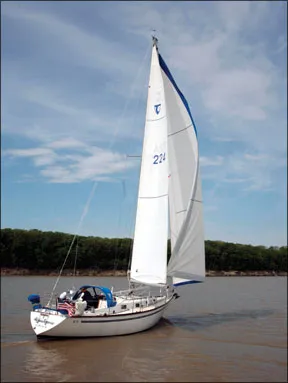
The Tartan 37 has the modern, clean, strong lines that typified S&S designs. The bow is raked, and the angle of the reverse transom is in line with the backstay-an easily missed detail that nevertheless affects the viewers impression of the boat. Freeboard is moderate and the sheer is gentle. In an early review, we wrote: “Underwater, the boat has a fairly long, low-aspect ratio fin keel, and a high-aspect ratio rudder faired into the hull with a substantial skeg.” In addition to the deep fin keel, a keel/centerboard also was offered. A distinctive feature is how the cockpit coamings fair into the cabin trunk. Its displacement/length ratio of 299 and sail area/displacement ratio of 16.1 rank it in the middle of the 9-model group (see table, page 9), so while it looks racy, its not going to smoke the other nine.
From its beginning, Tartan Yachts set out to build boats of above average quality, and this can be seen in both the finish and fiberglass work. Some unidirectional rovings were incorporated in the hull laminate to better carry loads; like the vast majority of boats of this era, the resin was polyester. Vinylester skin coats, which better prevent osmotic blistering, had yet to appear. Some printthrough is noticeable, more on dark-color hulls. The hull and deck are cored with end-grain balsa, which brings with it our usual warnings about possible delamination. The hull-deck joint is bolted through the toerail and bedded in butyl and polysulfide. Taping of bulkheads to the hull is neatly executed with no raw fiberglass edges visible anywhere in the interior. Seacocks have proper bronze ball valves. One owner advises checking the complex stainless-steel chainplate/tie rod assembly, especially if its a saltwater boat.
Shortcomings: Pulpit fasteners lack backing plates. Scuppers and bilge pump outlets have no shutoffs.
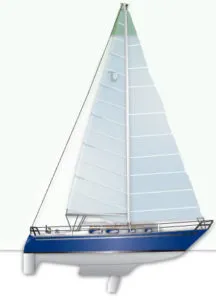
Under sail, the Tartan 37 balances and tracks well. As noted earlier, its not a fireburner, but not a slug either. Its no longer widely raced, but the few participating in PHRF races around the country have handicaps ranging from 135-177 seconds per mile. The Niagara 35 now rates 150-165, and the C&C 38 126-138.
The deep fin-keel version points a little higher than the keel/centerboard because it has more lift, however, the deep draft of 6 feet, 7 inches is a liability for coastal cruising.
Because of the large foretriangle and relatively small mainsail, tacking a genoa requires larger winches and more muscle than if the relative areas of the two were reversed. For relaxed sailing, jiffy reefing of the main and a roller-furling headsail take the pain out of sail handling.
The 41-horsepower Westerbeke 50 diesel provides ample power. Standard prop was a 16-inch two blade. A folding or feathering propeller reduces drag, thereby improving speed. Access to the front of the engine, behind the companionway ladder, is good. Unfortunately, the oil dipstick is aft, requiring one to climb into the starboard cockpit locker-after you’ve removed all the gear stowed there.
The layout below is straightforward with few innovations: large V-berth forward with hanging locker and drawers; head with sink and shower; saloon with drop-down table, settee, and pilot berth; U-shaped galley to starboard; and to port, a quarterberth that can be set up as a double. To work at the navigation station one sits on the end of the quarterberth. This plan will sleep more crew than most owners will want on board, but its nice to have the option. Pilot berths make good sea berths but often fill with gear that can’t easily be stowed elsewhere.
The fold-down table, like most of its ilk, is flimsy. Underway, tables should be strong enough to grab and hold on to without fear of damaging it or falling-thats not the case here. And the cabin sole is easily marred trying to get the pins in the legs to fit into holes in the sole.
Finish work in teak is excellent, though this traditional choice of wood makes for a somewhat dark interior. Today, builders have worked up the nerve to select lighter species such as ash and maple.
Eight opening portlights, four ventilators, and three hatches provide very good ventilation.
The standard stove was alcohol, which few people want anymore, owing to low BTU content (which means it takes longer to boil water), the difficulty in lighting, and almost invisible flame. Propane is a better choice, but there is no built-in stowage on deck for the tank, which must be in a locker sealed off from the interior and vented overboard. (You could mount the tank exposed on deck, but that would not complement the boats handsome lines.)

Theres not much to pick at here, but we’ll try. Centerboards come with their own peculiar set of problems: slapping in the trunk while at anchor, broken pendants and pivot pins, and fouling in the trunk that inhibits operation.
Often what sets apart higher-quality boats from the rest of the fleet is the cost of materials and labor in making up the wood interior. They look better than bare fiberglass, work better because they have more drawers and stowage options, and are warmer and quieter. The unnoticed flip side is that the joinerwork tends to hide problems, like the source of a leak. When all the fasteners are neatly bunged and varnished, it takes courage to start pulling apart the interior!
Checking engine oil is unnecessarily difficult, and to operate emergency steering gear (a tiller) the lazarette hatch must be held open, which could be dangerous. Lastly, the companionway sill is low for offshore sailing; stronger drop boards would help compensate.
Tartan 37 Conclusion
The enthusiasm for this boat is strong. In fact, theres a whole book written about it, put together with the help of the Tartan 37 Sailing Association (link below). You’ll pay in the mid- to high-$60s, which ranks it with the Niagara 35 and Freedom 36 as the most expensive of our nine. While Tartan 37s have made impressive voyages, and are as capable as the Niagara 35 and C&C Landfall 38, like them, its not really a blue-water design. We view it rather as a smart coastal cruiser and club racer. Good design and above-average construction give it extra long life on the used-boat market.
Classic Cruisers For Less Than $75,000
Niagara 35 Sailnet Forum
C&C Photo Album
Tartan Owners
Tartan 37 Sailing Association
RELATED ARTICLES MORE FROM AUTHOR
27 comments.
Great article, but why did you leave out your namesake build – Camper Nicholsons Nicholson 35. Very similar to the Niagara 35, except that it trades the (less than useful – my opinion) quarter berths for two GIGANTIC cockpit lockers. And I find the transverse head on the Nic a civilized alternative to telephone booth head/shower combinations.
While the Nic claims 6 berths, you’ll never find that many on ours. Cocktails for 6, dinner for 4, sleeps 2 is our mantra
This is great information and a good guideline to go by. Thanks for the heads up on theses vessels.
Every time Practical Sailor does a review of boats in the 35- to 38-footers built between 1978 and 1984, they always leave out the Perry designed Islander Freeport 36 and 38. Many people are still cruising in these great boats, and among Islander Yachts designs this one is a wonderful cruiser.
I was also sad to see that. We sail a ’79 I-36, and it is stiff, fast, forgiving, and a very comfortable cruising platform. While many of the 800+ built are ready for the wrecking ball, there are some excellent, well cared for boats available. They are lovely sailors.
Couldn’t agree more, with Islander Freeport 36 & 38 raised coachroof that opens up all sort of possibilities and transom based swim ladder, her utility is unmatched.
These are all nice boats. I have sailed most of them. I owned a Tartan 37 for 4 yrs. As A US Sailing Cruising instructor, I have sailed and cruised hundreds of boat. This is one of the best balanced and behaved boats that I have sailed. She will sail on jib alone with no lee helm and sail main alone with minimal weather helm. Few boats will do this. She tracks quite well in a seaway. There are only 2 instances that you need to put the centerboard down: clawing off a lee shore or racing upwind. Otherwise she is just fine with board up. I have not had problems with the board slapping in a rolley anchorage. I keep the board up tight all the way and no problem. And my boat a 1983 had a built in propane vented locker. Also my dipstick was forward port and easy to reach, but not so for the filter so I remote mounted it forward. S & S did a great job on this design. And a 4 foot draft is wonderful and special feature for a boat that sails so well.
Surprising that the author did not address the obvious question, “if you had to pick one of these for a bluewater cruise, which one would it be?”
I too would appreciate the author’s response to this question.
Every time I star liking one of these I see the word ‘balsa’
Why did you not look at the Catalina 36. They are sea kindly; easy to repair and get parts; there’s a lot of them; and newer ones are in the price range you are talking about.i.e. my 2002, well fitted, is $72500.
Good article, thanks.
Pearson 365 conspicuously missing from this list.
Excellent article with factors that almost all of us who own vintage older cruising sailboats have considered at one time or another. However, when making my choice and before putting my money down, I also included PHRF as a factor. Without degenerating into a large discussion of pros and cons of PHRF (or any other indexes of performance), I think that you should consider performance in the equation. While livability is important (and I am a comfort creature), the ability to run away from a storm or handle tough conditions, is also important, you don even mention it. Paraphrasing Bill Lee, “faster is fun”. After weighing all of the factors discussed above, and adding considerations for performance, I purchased a 1984 Doug Peterson designed Islander 40 for $65,000 and am still in love with the boat 15 yrs later. It still is a “better boat than I am a sailor” and is also very comfortable. The only drawback is that it draws 7’6″ which in SF Bay, is not a problem. On the “right coast” that might be a problem, but on the “correct coast” it has not been.
Hate to be picky but you left out of this old list a high quality design and blue water capable cruiser designed and made by quality Canadian company–Canadian Sailcraft, namely CS 36 T. A Sailboat 36.5 feet with all the necessary design and sailing numbers needed to be attractive , safe, and fast.
No one likes to see their favorite boat left off a list like this, but it must be done. But my Ericson 38 has almost none of the cons of the boats in this article, and most of the desireable pros. After 13 years of ownership, it hasn’t even hinted at breaking my heart. Great design pedigree, glassed hull/deck joint, ahead of its time structural grid, points high, extremely liveable interior, and the list goes on…so much so that I’m glad I didn’t buy ANY of the boats in the article instead.
Missing are the CSY 37 and 44. Ernest M Kraus sv Magic Kingdom CSY 44 walkover cutter
Very useful article. Thanks! I’d love to see the same framework for a selection of length 40′-50’ft coastal cruisers.
I know that it is hard to include all boats, but you missed a boat that fills all the requirements. I’m speaking about the Bob Perry designed and Mirage built 35. It has all the capabilities and handling characteristics that you would want in a capable cruiser and the speed of a steady over-performing racer-cruiser. It has 6’5″ headroom and all the standard features that are a must in a strong well built beauty with 5 foot draft, light but rigid and strong. Great for the Chesapeake bay or other depth challenging bodies of water.
Great publication through the year’s. Still miss my print version to read on rainy day. Owned a Cal 27 T-2 and Irwin Citation over the years. Sailed on the Chesapeake. The Irwin ended up in Canada. JA
We have a Swallow Craft Swift 33. The boat was made in Pusan Korea in 1980. For a 33′ boat it is cavernous. We live aboard 1/2 the year. I thought it might be a boat you would be interested in looking at. I call it a mini super cruiser.
How about the Pearson 367?
Surely this is a joke. I’ll put the Nonsuch 30 Ultra against anyone.
Good article, but another vote for the CS36T. No better value for an offshore capable, fast cruiser and built to last.
Great article
The list looks familiar to the list I was working with back around 2004. Back then the prices were even higher of course. To fit my budget, I got a great boat… Freedom 32. That is a Hoyt design from TCI. All I really gave up was some waterline. Below deck, the boat is as roomy as many 35-36 footers due to the beam. I find it to be a great boat for me. I do not see a move up to the sizes on this list to improve my lot. I could be tempted by a Freedom sloop over 44′ but that is retirement noise.
which edition of month/year of the PS Magazine is this covered in please, it would be great to know?
A great article, but what about the Young Sun 35 Cutter! a great offshore boat that I have sailed single handed from Canada to Hawaii and back, single handed, in rough conditions, but which was an incredible 30 days each way. Overall 40 ft. and 11 ft. beam. I believe also built by Bob Perry!
LEAVE A REPLY Cancel reply
Log in to leave a comment
Latest Videos
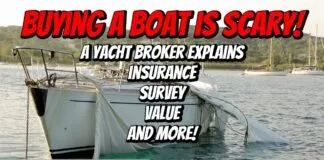
Buying A Sailboat Is Scary! Yacht Broker Interview

The Great Loop – The Basics

Bottom Paint Showdown – Six Paints, One Winner!

Tartan 30 | Boat Review
- Privacy Policy
- Do Not Sell My Personal Information
- Online Account Activation
- Privacy Manager

Great choice! Your favorites are temporarily saved for this session. Sign in to save them permanently, access them on any device, and receive relevant alerts.
- Sailboat Guide
1983 S2 11.0C
- Description
Seller's Description
1983 S2 11.0C The S2 11.0 , was born with innovation in mind, using vinyl ester gel coat early in her design gave her superior longevity, and sleek lines gave her the ability to withstand time. The boat looks the part of a traditional sailor and has the ability to handle the big weather. She is appointed well below and shows off her teak interior. A proven coastal and off shore cruiser with more room aboard than most 38 to 40 foot boats. This boat is in ship shape and ready to leave the dock tomorrow. Tired of looking for a cruising boat thats ready to go, not needing a lot of work, time, and money spent on equipment to get it ready. This one is ready! ALL SYSTEMS WORK! Affordable Cruising Sailboats - Practical Sailor (practical-sailor.com) S2 (manufacturer), 11(meter, 36 length), C (center cockpit)
Equipment: Engines Engine 1: Engine Brand: Universal Engine Model: M5432 Engine Type: Inboard Engine/Fuel Type: Diesel Engine Hours: Unknown Propeller: 2 blade propeller 16x12RH Engine Power: 32HP
Tanks Fresh Water Tanks: 1 Aluminum (75 Gallons) Fuel Tanks: 1 Aluminum (75 Gallons) Holding Tanks: 1 Fiberglass (15 Gallons)
COCKPIT IS FULLY ENCLOSED ROLL UP SHADES, PORT & STBD (NEW 2021) LEWMAR 16, 2 SPEED HAND WINCH IN COCKPIT, PORT SIDE LEWMAR 3, SINGLE SPEED HAND WINCH IN COCKPIT, STBD SIDE LEWMAR 42, 2 SPEED HAND WINCH OUTBOARD, PORT & STBD SIDES (NEW 2021) LEWMAR 46, 2 SPEED HAND WINCH OUTBOARD, PORT & STBD SIDES STANDING AND RUNNING RIGGING (NEW 2020) GENOA AND MAIN SAILS RECONDITIONED (2021) NEW MAINSAIL (2021) NEVER INSTALLED NEW ROLLER FURLER 2020 NEW PORT SEALS THOUGHOUT EXTRA PORT LIGHTS (NEW) 620 Ah HOUSE BATTERY BANK (VMAX AGM (NEW 2020)) BLUESEA HOUSE AND START AUTOMATIC ISOLATOR (NEW 2020) SOLAR VICTRON MPPT BLUETOOTH CONTROLLER (NEW 2020) 350w MONO SOLAR PANELS (NEW 2020) VICTRON BLUETOOTH BATTERY MONITOR (NEW 2020) PRONAUTIC 40A MULTI-CHARGER (NEW 2020) GARMIN ELECTRONCS SUITE (NEW 2021) UNDER WARANTY o GPSMAP 943xsv o GNX wind/speed/depth bundle o Panoptix Forward Sonar o GMR Fantom 18 solid state Radar o GARMIN VHF w/ DSC, Integrated AIS Transceiver and Loudhailer o All Blue Maps and Relief Shading Maps RAYMARINE ST6001 AUTOPILOT LINEAR DRIVE LED NAVIGATION AND INTERIER LIGHTING LEWMAR ELECTRIC ANCHOR WINCH ON FOREDECK (REBUILT 2020) 250 G4 ANCHOR CHAIN (NEW 2020) STAINLESS DELTA ANCHOR (OVERSIZED PRIMARY) DANFORTH W/ 100 CHAIN, 200 RODE DINGHY DAVITS ACHILLES HAPYLON RIB 92 W/ CHAPS TOHATSU 9.8HP OUTBOARD (NEW 2021) 6 FENDERS AND ALL NEW DOCKLINES (NEW 2021) 2 LARGE LAZARETTS ON AFT DECK STORAGE BOX ON AFT CABIN TOP 2 DOOR OPENING AND SLIDING HATCH FOR ACCESS TO SALON DECK FROM COCKPIT SALON WILL SEAT 6 SALON WILL SLEEP 2 V BERTH WILL SLEEP 2 AND HAS STORAGE SHELVES BOTH SIDES AND HAS AN OPENING HATCH CAPTAIN CABIN SLEEPS 2 REMOVABLE TABLE IN SALON SAMSUNG TV W/REMOTE WEBASTO, 110VAC, HEATING/AIR CONDITONING SYSTEM ( 1 YR OLD) KUUMA, 110VAC, WATER HEATER WITH ENGINE HEATED BYPASS (1 YEAR OLD) HEAD HAS COMPOSTING TOILET (PLUMBING INTACT) HEAD HAS A SHOWER/TUB GALLEY HAS LARGE SINK 2 BURNER ALCOHOL STOVE WITH OVEN SPICE RACK 3 LARGE DRAWERS GALLEY HAS DRY STORAGE, SEPARATE FREEZER AND A SEPARATE REFRIGERATOR WITH SMALL FREEZER AND SEPARATE CLOSET MICROWAVE
2500W, PURE SINE WAVE INVERTER UNIVERSAL M5432, 4 CYLINDER, UNIVERSAL DIESEL WITH DUAL RACOR FILTERS AND SHUTOFF VALVE (NEW HEAT EXCHANGER 2021) HONDA EU2000 GENERATOR (ONE PULL START) CAPTAINS CABIN HAS HANGING CLOSET, STORAGE COMPARTMENTS, DRESSER WITH STORAGE /SEAT, & AN UPPER SHELF FULL LENGTH OF CABIN ON PORT SIDE. THERE ARE 3 LARGE STORAGE COMPARTMENTS ON THE STBD SIDE AND AN OPEN 2 SHELF STORAGE AMIDSHIP ON BULKHEAD. CAPTAINS CABIN HAS AN OPENING HATCH STAINLESS STEEL STEPS MOUNTED TO MAST ALL USCG SAFTEY AND EQUIPMENT REQUIREMENTS CURRENT
Rig and Sails
Auxilary power, accomodations, calculations.
The theoretical maximum speed that a displacement hull can move efficiently through the water is determined by it's waterline length and displacement. It may be unable to reach this speed if the boat is underpowered or heavily loaded, though it may exceed this speed given enough power. Read more.
Classic hull speed formula:
Hull Speed = 1.34 x √LWL
Max Speed/Length ratio = 8.26 ÷ Displacement/Length ratio .311 Hull Speed = Max Speed/Length ratio x √LWL
Sail Area / Displacement Ratio
A measure of the power of the sails relative to the weight of the boat. The higher the number, the higher the performance, but the harder the boat will be to handle. This ratio is a "non-dimensional" value that facilitates comparisons between boats of different types and sizes. Read more.
SA/D = SA ÷ (D ÷ 64) 2/3
- SA : Sail area in square feet, derived by adding the mainsail area to 100% of the foretriangle area (the lateral area above the deck between the mast and the forestay).
- D : Displacement in pounds.
Ballast / Displacement Ratio
A measure of the stability of a boat's hull that suggests how well a monohull will stand up to its sails. The ballast displacement ratio indicates how much of the weight of a boat is placed for maximum stability against capsizing and is an indicator of stiffness and resistance to capsize.
Ballast / Displacement * 100
Displacement / Length Ratio
A measure of the weight of the boat relative to it's length at the waterline. The higher a boat’s D/L ratio, the more easily it will carry a load and the more comfortable its motion will be. The lower a boat's ratio is, the less power it takes to drive the boat to its nominal hull speed or beyond. Read more.
D/L = (D ÷ 2240) ÷ (0.01 x LWL)³
- D: Displacement of the boat in pounds.
- LWL: Waterline length in feet
Comfort Ratio
This ratio assess how quickly and abruptly a boat’s hull reacts to waves in a significant seaway, these being the elements of a boat’s motion most likely to cause seasickness. Read more.
Comfort ratio = D ÷ (.65 x (.7 LWL + .3 LOA) x Beam 1.33 )
- D: Displacement of the boat in pounds
- LOA: Length overall in feet
- Beam: Width of boat at the widest point in feet
Capsize Screening Formula
This formula attempts to indicate whether a given boat might be too wide and light to readily right itself after being overturned in extreme conditions. Read more.
CSV = Beam ÷ ³√(D / 64)
A = Aft Cabin. (The S2 11.0 C is a center cockpit version.) Shoal draft version: 4.67’/1.42m. Delivered with Universal, Volvo, or Yanmar engines.
This listing is presented by SailboatListings.com . Visit their website for more information or to contact the seller.
View on SailboatListings.com
Embed this page on your own website by copying and pasting this code.
- About Sailboat Guide
©2024 Sea Time Tech, LLC
This site is protected by reCAPTCHA and the Google Privacy Policy and Terms of Service apply.

COMMENTS
Looking for Sail Boats? We have almost everything on eBay. But did you check eBay? Check Out Sail Boats on eBay.
Introduced in 1977, the S2 11.0 reflects the maverick disposition of her makers, the quest for a better mousetrap, and the market savvy of a successful entrepreneur. ... According to the BUC Used Boat Price Guide, a 1981 model S2 11.0 (in both center- and aft-cockpit versions) has a retail value range today between $48,000 and $52,000 ...
(The S2 11.0 C is a center cockpit version.) Also referred to as simply the 11.0 Shoal draft version: 4.67'/1.42m. ... Like the LWL, it will vary with the weights of fuel, water, stores and equipment. A boat's actual draft is usually somewhat more than the original designed or advertised draft. For boats with adjustable keels (centerboards ...
How much do S2 boats cost? S2 boats for sale on YachtWorld are available for a variety of prices from $9,900 on the relatively lower-priced models, with costs up to $55,000 for the most expensive, custom yachts. What S2 model is the best? Some of the best-known S2 models now listed include: 9.2, 11.0 A, 11C, 9.2C and 11.0A.
The S2 11.0 Sailboat. The S2 11.0 is a series of American cruising sailboats that were designed by Arthur Edmunds and built by S2 Yachts, a company founded by Leon Slikkers, a former Chris Craft employee who started his own boatbuilding business in 1973. The S2 11.0 series includes an aft-cockpit model (11.0A) and a centre-cockpit model (11.0C).
The S2 11.0 is a series of American sailboats that was designed by Arthur Edmunds as cruisers and first built in 1977. The designation indicates the approximate length overall in meters. [1] [2] [3] [4]
1979 S2 11.0 A. US$36,800. ↓ Price Drop. HarborView Yacht Sales, LLC | Northport, Michigan. <. 1. >. * Price displayed is based on today's currency conversion rate of the listed sales price. Boats Group does not guarantee the accuracy of conversion rates and rates may differ than those provided by financial institutions at the time of ...
S2 11.0 A is a 35′ 11″ / 11 m monohull sailboat designed by Arthur Edmunds and built by S2 Yachts between 1977 and 1987. Great choice! Your favorites are temporarily saved for this session. Sign in to save them permanently, access them on any device, and receive relevant alerts.
Introducing a 1979 S2 11.0 Sailboat - a timeless vessel that seamlessly blends classic design with enduring performance. As a prospective buyer, you'll find yourself captivated by the graceful lines and sturdy construction that define this nautical masterpiece. ... The 1979 S2 11.0 is equipped with a reliable auxiliary engine, ensuring peace ...
S2 Yachts. USA 1974 — 1989. Overview. The company, located in Holland, Michigan, USA, was founded by boating industry legend, Leon Slikkers, after he had sold his powerboat company, Slickcraft. As part of the sales agreement, he was precluded from the powerboat market for a number of years. ... S2 11.0 C. 1980 • 35 ...
1981 S2 11.0A. US$29,000. ↓ Price Drop. Capital City Yachts | Olympia, Washington. <. 1. >. * Price displayed is based on today's currency conversion rate of the listed sales price. Boats Group does not guarantee the accuracy of conversion rates and rates may differ than those provided by financial institutions at the time of transaction.
S2 11.0 C Detailed Review. 1 of 1. If you are a boat enthusiast looking to get more information on specs, built, make, etc. of different boats, then here is a complete review of S2 11.0 C. Built by S2 Yachts (USA) and designed by Arthur Edmunds, the boat was first built in 1980. It has a hull type of Fin with rudder on skeg and LOA is 10.97.
S2 Yachts (USA) The company, located in Holland, Michigan, USA, was founded by boating industry legend, Leon Slikkers, after he had sold his powerboat company, Slickcraft. As part of the sales agreement, he was precluded from the powerboat market for a number of years. There were no restrictions on sailboat building.
S2 Yachts were built in Holland, Michigan from 1974 thru 1989. Known for good build quality and sailing characteristics. ALOHA has been loved and updated by the seller since 2006. Set-up for short handed sailing and equipped for comfortable cruising - ALOHA will not disappoint. Check this out: Less than 1000 hours on the 2009 rebuilt Volvo diesel.
So the 9.2 was taken off our list. We continued looking at other brands in the 30' to 37' range, preferably with an aft cabin and mandatory, fairly shoal draft. The S2 11C has LOTS more room/space based on the video tours we've seen on YouTube.
SailNet Archive. 87689 posts · Joined 1999. #3 · Nov 6, 2006. I have owned an S2 11.0A for a number of years that I sail mainly on the Chresapeake Bay and have taken it up and down the east coast. An excellent coastal cruiser, substantial displacement, good tankage, and very stable and able boat. I would take it offshore coastal and to ...
Sep 6, 2011. #6. Speed potential is more sail area, waterline length, lighter vessel, rather than beam, other than the fact that when you heel over the beam will increase waterline length for certain vessels. I believe S-2 is considered to be a better built boat than the Islander, with better fiberglass work, but, as mentioned, the Islander 36 ...
S2 11.0. Built in Holland, Mich., the S2 sailboat line emerged in 1973 when owner Leon Slikkers sold his powerboat company, Slickcraft, to AMF and had to sign a no-compete agreement. The 11.0 was the largest model, introduced in 1977. The designer was Arthur Edmunds, who also drew the Allied Princess 36, though the two are very different.
S2 preowned sailboats for sale by owner. S2 used sailboats for sale by owner. Home. Register & Post. View All Sailboats. Search. ... Sailboat Added 11-Jul-2021 More Details: S2 9.2 Center Cockpit: Length: 30' Beam: 11' Draft: 3'11' Year: 1987: Type: cruiser: Hull: fiberglass monohull:
S2 11.0 C is a 35′ 11″ / 11 m monohull sailboat designed by Arthur Edmunds and built by S2 Yachts between 1980 and 1987. Great choice! Your favorites are temporarily saved for this session. Sign in to save them permanently, access them on any device, and receive relevant alerts.
1983 S2 11.0C The S2 11.0 , was born with innovation in mind, using vinyl ester gel coat early in her design gave her superior longevity, and sleek lines gave her the ability to withstand time. The boat looks the part of a traditional sailor and has the ability to handle the big weather. She is appointed well below and shows off her teak interior.
Join Date: Sep 2016. Location: Oregon. Boat: Chrysler 26, swing keel. Posts: 130. S2 11 (36') Center cockpit. Hello to all! Absolutely love this website! Have learned and shared a lot here. I previously started a thread in this forum regarding the S2 9.2 center cockpit with both my wife and I thinking this would be our next boat.
1985 S2 11.0C 36 Center Cockpit. US$28,999. ↓ Price Drop. Sunshine Cruising Yachts | Jacksonville, Florida. Request Info. <. 1. >. * Price displayed is based on today's currency conversion rate of the listed sales price.